-
Some Bus Infrastructure
I’m now on my way to the Netherlands from Denmark via excellent train service. Without much context, here are some pictures I took of bus infrastructure in Denmark and a few from Malmo, Sweden. Bus service was frequent and reliable and had significantly more amenities than normal in the US. This was true in urban areas, where a great many stops had real time and connecting bus information. Buses in urban areas were often all-door boarding and featured screens with realtime and connecting information on the bus. Many of the bus stops I saw were not as attractive as Eugene’s EmX stations, but they were extremely practical with all of the amenities a person would need while waiting for a bus.
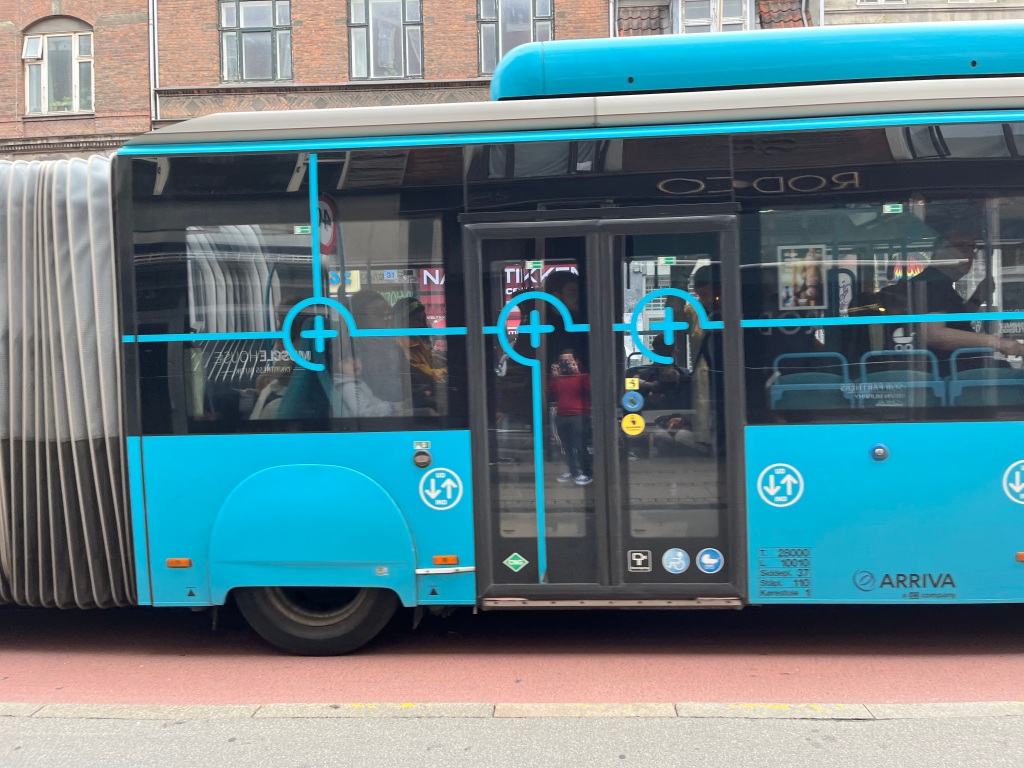
Extra wide doors on the buses in Copenhagen. 
Standard bus stop in Copenhagen with real time information and bus schedules. 
Larger bus stop in Copenhagen. The real time sign is much bigger – they are typically small and built into the shelter. 
Real time sign for a BRT line in Malmo, Sweden. 
Real time and connection information on the BRT line in Malmo. Regular buses in Copenhage, Odense, and other cities had this too. 
80-ft double articulated electric bus! 
BRT runs out to the edge of development. Presumably, this area will develop in the future and transit will be available on day one. 
Open payments and validators at each door allow for all door boarding. 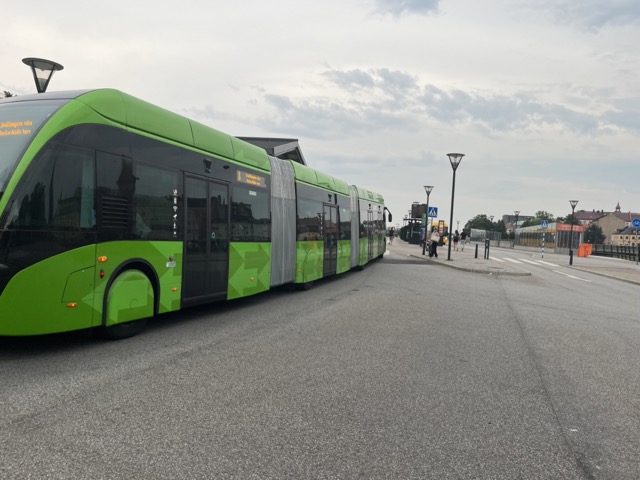
Another shot of the 80-ft electric bus. 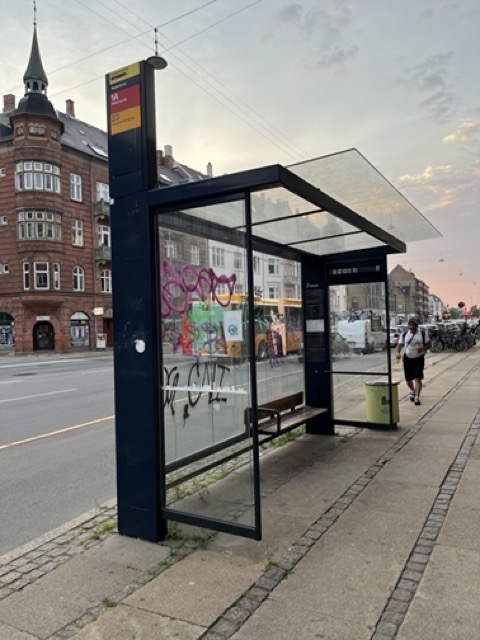
Standard Copenhagen bus stop. Note the real time information built into shelter. 
Bus pole where they couldn’t put a shelter because of space. Note that it still has real time information. 
Rural bus stop. 
Another rural stop. 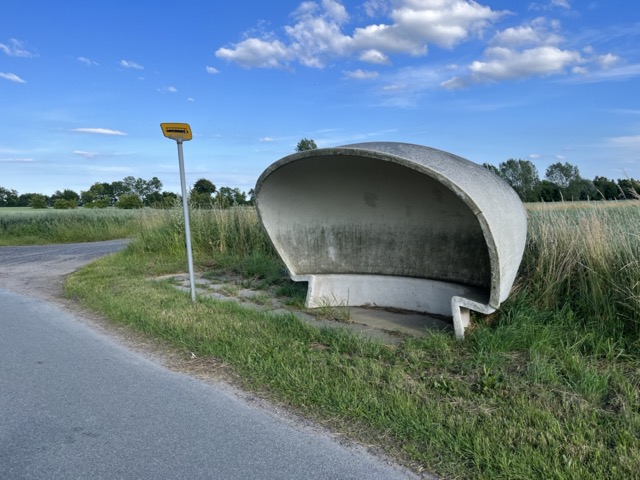
A very rural bus stop outside Odense. 
Real time information on the bus transfer point at the train station. Real time information is available all over the station. As I’m moving to the Netherlands, I’ll get some additional posts up on Denmark. In particular, I hear at work that “Eugene is not Copenhagen,” however, Odense is approximately the same size, the suburbs of Copenhagen look a lot like the suburbs of Eugene.
-
Infrastructure Expectations (pt. 2)
I shared some photos and differences in my last post. For this post I want to start thinking about how the design relates to my experiences and how that relates to my work in Oregon.
I’m a seasoned cyclist who rides thousands of miles a year. I own bikes I’ve ridden 20,000 miles on. I was actually intimidated when I first started riding in Copenhagen, because the experience was so different than what I’m used to. With so many bike lanes it can be difficult to navigate at first. In the US, bike infrastructure tends to channel you onto one or two streets, and it’s clear when you get to the next street that’s decent to ride on that you should take that way. Also, it’s illegal to turn left here – you make a right, then wait for the light and go straight. People here also ride very confidently and pass closely. In Eugene, we have people who complain about much less close interaction on the bike paths, but in Copenhagen people in suits and dresses will be elbow to elbow with you while riding. It’s very similar to riding in a group of road cyclists.
After a day or so, I got used to how people here ride and could really start to appreciate what a dense network of connected, safe facilities does for people when they need to get somewhere on a bike. The short answer is that it’s incredible. The mental load of wondering how to safely get somewhere is gone. As is the constant voice in the back of your head that you’re one distracted driver crossing the paint from a serious injury or worse. Beyond that, it feels like freedom. Movement here feels unrestricted in ways that I don’t feel in the United States – even while driving in a car.
Nearly all of that is tied back to the infrastructure that is clearly designed for (not designed to accommodate) someone riding a bike. Some of it is cultural. People driving all ride bikes sometimes and are extremely courteous and watch for cyclists, though they will get close to you (at slow speed) and will even go through gaps of pedestrians in a crosswalk. But the infrastructure is really carrying the load on providing freedom.
That sense of freedom comes from knowing that I will be safe wherever I want to go. It comes from having a dense network of facilities that allows me to go anywhere and doesn’t force me to go far out of my way to feel safe.
On the infrastructure, though, I have noticed a really big difference in how Danes design things. The best way to describe it is that everything is about context here. In the US, I hear engineers say they can’t do something that makes sense, because the MUTCD or some other engineering principle prevents them from doing what is logical. I empathize with them because they have a professional liability. I asked a planner here about standards, and he confirmed my suspicion that design standards do exist here, but they’re guidelines and not rules. the result is that each piece of infrastructure feels similar, but nothing is quite the same. Things are not as standardized, but they do make sense.
It really feels that culturally because of how we engage in more litigation and how we rely on standards, the Danish approach is not feasible in Oregon right now. I’m not an engineer, so I don’t know how to change how we’re designing things in a way that allows them to exercise their judgement, but it feels that is necessary to start to get some of the magic that I’m feeling while riding here. Engineers in the US do try innovative things, but very incrementally and in small demonstrations. I would love to see them free to throw out the manual and start to design bikeways that make sense.
We also tend to really over-engineer things. As I mentioned, there really isn’t a lot that goes into a bikeway in Copenhagen other than 8 or 11 feet of pavement, raised up above street level a few inches with a curb, and perhaps some protection by way of parked cars. In the US, I expect to see lots of paint marking conflict zones, striping of various colors, signs everywhere, and exclusive phases for bike lights when they’re provided. Here the simple approach seems to work better. While there may be some middle ground, I think the proof is in the numbers and we have much higher rates of injury for people walking and biking (and also for people inside the car). Other North American big cities have a similar feel to Eugene, but scaled up. Vancouver, BC has bikeways that look and feel like the ones in Eugene, but many more of them. They don’t feel like Copenhagen. Riding on them is just much more stressful.
Roadway space for cars is less engineered as well. People drive more slowly and watch out for folks more. I have to wonder whether that’s because the Danes don’t try to maximize traffic in a very specific way, leading to a high degree of separation and a feeling that when it’s your turn to go, nobody else should be in your way. I’ll note here that driving here isn’t a worse experience (at least I don’t think it would be). People tend to go slowly when around others, hold their line, and make their intentions clear, regardless of what mode they use. It results in little delay for anyone. There is less traffic congestion in Copenhagen at commute times and during the day than there is in the city of Eugene.
The best way to describe the simplicity of riding here is it’s more or less the feeling you get while riding on the river paths in Eugene – stress free and enjoyable. The only difference is that you get this feeling pretty much everywhere you go.
I don’t have a solid takeaway yet on what to do about these thoughts. I am left with the feeling that we greatly over-engineer roadways and bikeways in the US in a way that doesn’t make us safer and doesn’t really lead to better travel times for anyone – including people driving. Culturally, that would be a big shift away from how we’ve been building roadways and it would require serious buy in from a lot of folks, including the whole engineering field.
-
Infrastructure Expectations (pt. 1)
Having never been to Copenhagen, my expectations were that infrastructure was essentially like what we have in the US, but more of it. I thought perhaps that they had new, innovative engineering techniques that would make it amazing to bike around. Since arriving, I’ve been overwhelmed by how easy and enjoyable it is to bike around and underwhelmed by their engineering. Upon reflection, I think this has much more to do with how my expectations are anchored in North American design standards and nothing to do with what makes a city work for people on bikes. Here are some photos that help explain what I mean.
Bike parking in the United States is often required by code. Eugene has some great standards for long term and short term parking. It usually looks something like this (or much worse in many cases):
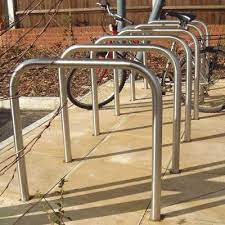
In Copenhagen, there certainly is a lot of bike parking, but not everywhere. Structured bike parking is only found at major places like train stations or shopping centers (pictured on the left). Most of the time, you just find a spot on the sidewalk and lock your wheel (pictured on the right). Theft appears to be part of the reason for lack of security, but it’s still interesting that there is surprisingly little parking for the number of bikes you see around town.

Bike parking at the Botanical Gardens in central Copenhagen. 
Bike parking at a metro station in central Copenhagen. Bike lanes are not at all like what you see in the United States. I expect a “high quality” bike lane to have lots of paint, probably in different colors like green, to differentiate where people are supposed to be. Copenhagen has significantly less paint on the roadway and basically none on bike lanes. Bike lanes are also raised up by curbs, but lower than the sidewalk. I have only found one area that had painted bike lanes. Usually areas without bike lanes can be shared with cars, though they don’t bother with sharrows, presumably because everyone knows they will be sharing. Also bikes can ride the wrong way down many one way streets to improve connectivity. I was surprised that there is not any right of way designed for this, it’s just allowed. Cars will stop and let you pass them if you’re going the wrong way and there are cars parked on both sides.

These signs exclude cars, but permit bicycles to go against one way traffic. There are a lot of bike lights here on major roadways. Sometimes there aren’t lights, but on most arterials bikes have their own light and they are not always timed to be with the pedestrian phase nor with the car phase (but generally all of these are timed together). Occasionally, I’ll find a mid-block bike light that is intended to let pedestrians use a crosswalk. Compliance with signals is very high here.
One other huge difference I’ve noticed is how they use ramps to accommodate mobility devices, strollers, etc. going up and down the curbs for bike lanes and then up again to the sidewalk level. I’m unsure if there is the equivalent of the American’s with Disabilities Act, but the infrastructure is not at all like what we do. Again, in the United States, there are highly prescribed rules for slope, angle, tactile pads, etc. In Denmark every location looks like the ramp below – a tiny ramp made of asphalt. They all look similar, but I presume they are just added by the construction workers and not engineered in any way that would resemble how we do ramps. While I err towards saying we do them better (even if we spend a fortune on them), I haven’t had trouble with them while walking my bike. I’m an able bodied person, so my experience may be way off, but they didn’t seem any more challenging than ramps in Oregon.

Typical ramp to get up to the curb height. This one allows you to walk straight through the small roundabout. My next post will try to wrap some of these infrastructure observations together into a series of questions and perhaps some takeaways.
-
About this trip
I am a transportation planner at Lane Transit District in Eugene, Oregon. My job involves long range planning studies, coordinating with our regional partners, and – most relevantly – co-managing a project with City of Eugene staff that will transform major corridors in Eugene.
This blog isn’t really about my work, though it is related. This blog will serve as a repository for observations and reflections on my experiences as I study in Denmark and the Netherlands. From June 18 – July 12, I’ll be on a study tour focused on creating cities with great bicycle transportation. As a transit planner, I’ll also be taking notes on transit systems and the design of their infrastructure. The course is organized through the University of Oregon. In addition to the students studying abroad, there are also 6 professionals (including myself) from Oregon who will be learning with the goal of coming back to our communities with fresh ideas and comparisons that can help move the needle on our local transportation systems. The Scan Design Foundation graciously provided funding to make this trip happen.
-
Subscribe
Subscribed
Already have a WordPress.com account? Log in now.